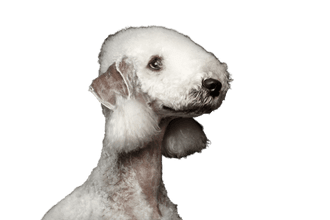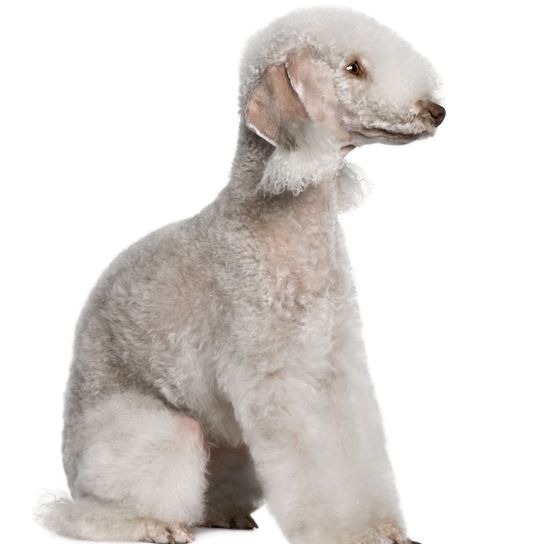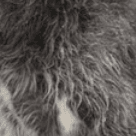
Bedlington Terrier Breed description: Character & Co
Bedlington Terrier
Facts & Origin
Although the Bedlington Terrier visually resembles a sheep, behind his harmless exterior hides a skilled hunter with a pithy character. Because of his incompatibility with conspecifics, he is also called the "wolf in sheep's clothing".
What is the origin of Bedlington Terriers?
The Bedlington Terrier is descended from greyhounds, otterhounds and Scottish terriers. It was mainly kept by poorer classes and used for rat control. The dog accompanied miners down mine shafts and was used in dog competitions. In time, the hardworking dog breed was also appreciated by the upper classes of society. Through the crossbreeding of poodles, the coat care could be simplified. In 1869, the foundation of the first pedigree dog club took place, the Rothbury Terrier became a show dog. As an independent breed, the dog is assigned to standard number 9, group 2, section 1. Since 1932 there has been a kennel club for Bedlington Terriers in Germany.




| Alternate Name | - |
| Origin | Scotland |
| Life expectancy | 14 - 15 years |
| Care requirements | high-maintenance |
| Activity level | average |
| FCI group | Poodle |
| AKC group | Terrier Group |
| KC group | Terrier Group |
Attitude, character and temperament of the breed
Temperament and disposition
The Bedlington Terrier is a confident and courageous terrier. He is alert and always ready to defend his family and home. In his home, he behaves calmly and pleasantly. The terrier is strongly attached to his family. Towards strangers it is reserved, but tolerates them. Towards conspecifics he behaves dominant and aggressive. If the Bedlington Terrier puppy is well socialized, it gets along well with children and likes to play persistently. When raising this intelligent dog, you must be consistent. The Bedlington Terrier puppy is always prone to testing its limits. The dog needs to be kept busy enough physically and mentally. It is well suited for dog sports. If the terrier is not sufficiently exercised, it can react aggressively. You can control the strong hunting instinct with tracking training and dummies.
Character
Usage

Health and breeding information
What are typical diseases of Bedlington Terriers?
Although the Bedlington Terrier is a robust dog, some hereditary diseases occur in this breed:
- Copper toxicosis: increased copper is stored in the liver.
- Brittle bone disease
- Entropion: the eyelid is rolled inwards
- Hyperkeratosis: the pads are very horny
Bedlington Terrier breeding - where, how, what?
The Bedlington Terrier breeding is mainly done in Great Britain. Since in Germany only a few dogs are used for breeding, you have to expect longer waiting periods when buying a Bedlington Terrier puppy.
Information about breeders can be found at:
- www.terrier.at
- Club for Terriers e.V.
- https://www.vdh.de


Breed characteristics
The medium sized, tall terrier has a wiry body. The head is pear-shaped, the ears hang down. There are long fur fringes at the lower ends of the ears. The front legs with the rabbit-like paws stand wide apart. The arched back determines the characteristic appearance. The low set tail has a pointed end and is carried hanging down.
Appearance and coat of the Bedlington Terrier
The dense coat is curly and stands slightly off the surface of the skin. The flaxen hairs are especially prominent in the head area. If the Bedlington Terrier is unshorn, the coat tends to form corkscrew curls. To prevent the coat from matting, it must be trimmed regularly with scissors. The FCI recognizes sand, liver and blue as coat colors. Tan markings are permitted. The dense mop of hair on the head is usually white. Dogs with darker colors are preferred. A wiry coat is not desirable.
How tall is the Bedlington Terrier?
- Male: 40 to 44 cm
- Bitch: 38 to 41 cm
How much does he weigh
- Male: 8 to 10 kg
- bitch: 7 to 9 kg
How old can this terrier from Scotland become?
The average life expectancy is between 14 and 15 years.
| Fur length | medium |
| Fur | curly |
| Ear shape | Floppy Ear |
| Tail | short |
| Anatomy | sporty |
| Size ♀ | 38 - 41 cm |
| Weight ♀ | 8 - 9 kg |
| Size ♂ | 40 - 44 cm |
| Weight ♂ | 9 - 10 kg |
| Suitable For | - |
Colors




Known Diseases
Joint damage
In some breeds, joint damage can occur later in life, affecting the musculoskeletal system.
Other medium dogs
Useful Articles
You can find articles that might interest you in the dogbible blog to match your favorite breed.
Visit our magazineto stay up to date on dog trends.
To find out more, view our Privacy Policy
Find here the breed that suits you and find out what character traits it has. Here you can also learn more about the origin, size and weight of your favorite breeds.
Matching your favorite breed, you'll find articles that might interest you on the dogbible dog blog.
Holiday with dog Baltic Sea - these tips you should know in advance!
Apps for dog owners - these 10 apps you should know about
Tattoos with dog theme: We have the cutest net finds for you






















